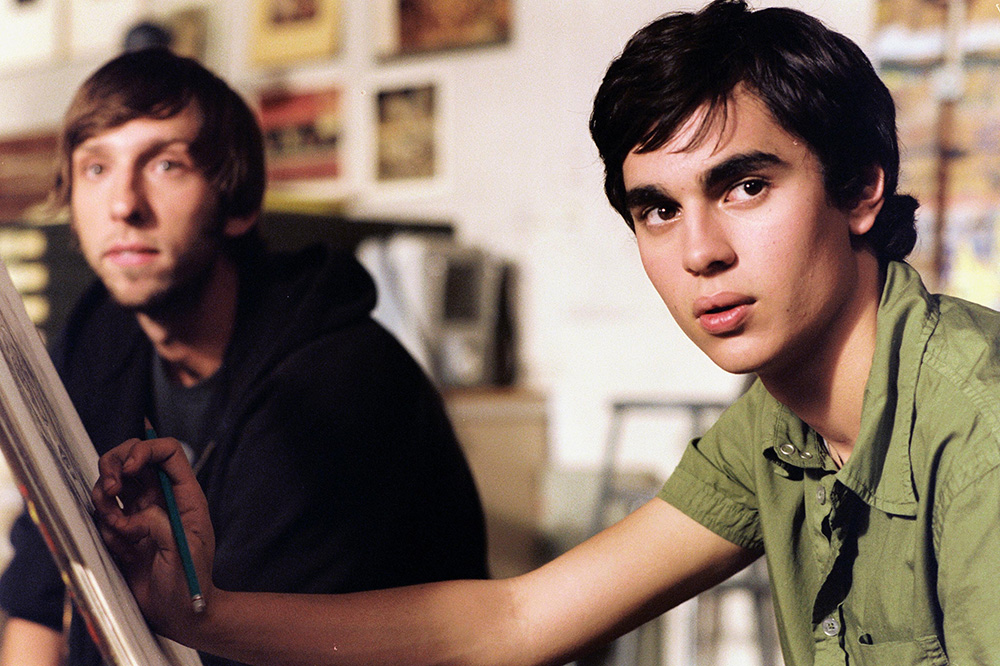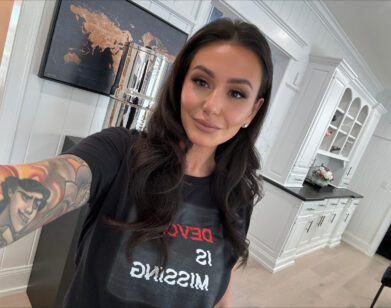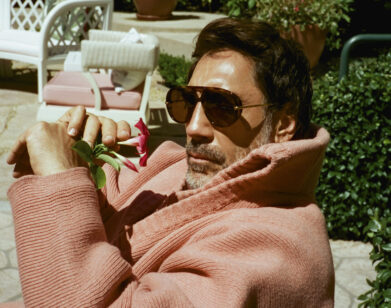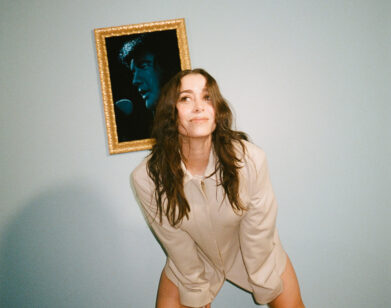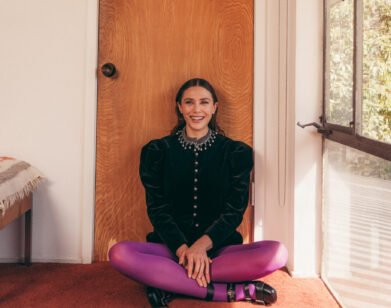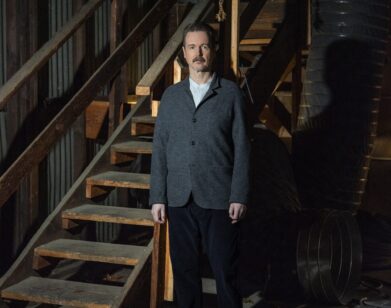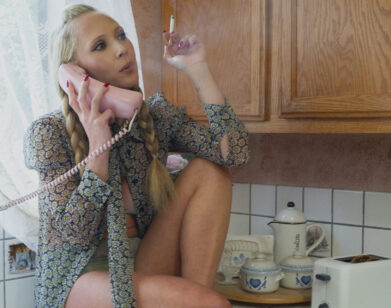The Sly Poetics of Terry Zwigoff
“I can’t relate to 99 percent of humanity,” says a character in Terry Zwigoff’s perceptive cult film Ghost World (2001). That movie—an ode to alienation, loneliness, and the melancholy process of growing up—was inspired by the graphic novel of the same name by Daniel Clowes. It’s a bittersweet comedy with a strange but alluring rhythm that intricately captures the peculiar moods and emotions of its characters, which include two teenage girls, Enid (Thora Birch) and Rebecca (Scarlett Johansson); Seymour (Steve Buscemi), a middle-aged record collector; and various other characters in an unnamed suburban town. Zwigoff and Clowes collaborated on Ghost World‘s Oscar-nominated screenplay. With its intentionally oversaturated colors, quirky characters, and offbeat dialogue, the movie bears the signature features of Zwigoff’s work.
Ghost World was Zwigoff’s first fictional film. Previously, he had made Crumb (1995), a startling documentary about a celebrated underground cartoonist that won the Sundance Film Festival’s Grand Jury Prize. Zwigoff’s other films include Bad Santa (2003), a wicked (but redemptive) comedy starring Billy Bob Thornton and Tony Cox that was a commercial hit; Art School Confidential (2006), a deft satire, loosely based on a short comic by Clowes; and Louie Bluie (1985), an hour-long documentary portrait of obscure musician, artist, and storyteller Howard Armstrong.
Zwigoff’s movies are filled with playful touches, as well as withering commentary about consumer culture. In Art School Confidential, there’s an Apocalypse Now poster on a film student’s dorm-room wall and a cat adoption flyer that’s visible during a gruesome campus crime. In a single scene in Ghost World, we see signage for Popeyes, Radio Shack, ProNutrition, Sony Panasonic, and Budweiser, while in Crumb, we see glimpses of Payless Shoe Source, Foxy Lady Boutique, and Picway Shoes.
Ahead of a film series devoted to his work at Metrograph, the Lower East Side movie theater in New York, we corresponded with Zwigoff over email. Over six days, he answered our questions—sending a batch of responses each day. He’s mild-mannered, but friendly and generous, with a lightness that wasn’t evident in earlier profiles. Despite his own occasional feelings of alienation, one of the reasons Zwigoff’s films are so insightful is that he’s empathetic and attuned to the feelings of others. “I try to relate to almost every single character in my films,” he writes. “It makes them much easier to direct.”
JULIA YEPES: It’s hard to think of a movie that, across the board, is as well cast as Ghost World. From the nameless faces on the periphery to the main and supporting roles, were there actors in the film who you had the idea to cast or who you really wanted for their roles?
TERRY ZWIGOFF: I was lucky enough to get my first choice for almost every single part in the film, which was a minor miracle in itself. Except for Brad Renfro. He wasn’t my idea. I wanted someone much more naturally reticent and introverted [for Josh]. Brad was a rambunctious, outgoing sort. That said, he did a good job, considering the casting was so faulty. And Teri Garr did a fine job [as Maxine], but she wasn’t my idea. I was having a difficult time finding someone for that part when Steve Buscemi suggested her. And she was terrific.
YEPES: You’ve said that the first place that most films go wrong is in casting. In the case of Ghost World, Thora Birch and Scarlett Johansson were not necessarily obvious choices for the roles of Enid and Rebecca. You thought Thora was better suited to play the role of the conventionally attractive Rebecca than she was to play Enid, the maladjusted one. Do you think that the casting of the two leads added a dimension to the film that wasn’t in the graphic novel?
ZWIGOFF: I wasn’t as concerned with adding another dimension to the film as I was with maintaining a feeling of truth. I recall having a hard time convincing everyone to go along with me wanting to cast Scarlett. I’d seen her in Manny & Lo (1996) and The Horse Whisperer (1998) and I thought she was really terrific. The studio wanted a bigger name and was suggesting a number of older actresses to me, most closer to 30. I thought if this thing were to have any chance of feeling real at the end of the day, we had to hire actresses who were actual teenagers. Scarlett was actually only 15 at the time, but she certainly had the poise to play a little older. Hell, she probably had enough poise to play 35! And then the studio, in their quest for bigger names, suggested Thora after American Beauty (1999) was a big hit. I originally was wary of hiring her for the role of Enid because she played a somewhat similar role in American Beauty and I wanted to differentiate between the two parts. But Thora was really persistent and dedicated and really wanted the part and kept after me. She actually gained 20 pounds to play Enid which I think helped a little bit, but it was her acting ability that really made it work.
YEPES: The theme of the two friends growing apart is at the heart of Ghost World. How much did you, Thora, and Scarlett talk about the friendship between Enid and Rebecca beforehand? How did Thora and Scarlett develop the relationship of two college-age girls who’ve probably known each other all of their lives?
ZWIGOFF: I don’t recall if we ever spoke of it directly, or anyone in the cast or crew having a hand in it. I give full credit to Thora and Scarlett for building a convincing friendship in a very few days before we had to start shooting.
I’m not sure to this day how they pulled that off, but we all hit it off and had a lot of laughs together, on and off the set—I think that helped. I try to make the set as relaxed and fun and stress-free as humanly possible, while still having control over things. It’s usually tension that hurts a performance or makes it seem self-conscious.
YEPES: Seymour provides an interesting parallel to Enid, and in a sense, his inclusion makes the movie more poignant. Both he and Enid are lonely and both he and Enid are misunderstood. By including Seymour in the movie, Enid has to confront the notion of unfulfilled adulthood more directly. Were there other ideas or issues you wanted to introduce through Seymour’s character?
ZWIGOFF I wanted to make it a romantic comedy, as well as a coming-of-age story. And through his character, I was able to make it a social and cultural satire as well.
YEPES: Near the end of Ghost World, there’s a shot of a pensive Enid walking through town. There’s a melancholy soundtrack, and a middle-aged sportswear-clad man with a soda and a bag of fast food passes through the frame. The inclusion of these weird, sad characters is the sort of personal touch of yours that adds a layer of pathos and humor, but that also serves as commentary about your view of the world. And in Crumb, there are striking sequences that show people outdoors who seem to reflect aspects of Robert Crumb’s perspective. When you made Louie Bluie and Crumb, were you thinking about the kinds of details you could incorporate into fictional films that would make them seem more true to life? Had you wanted to make fictional films long before Ghost World?
ZWIGOFF: Incorporating details was more of a natural inclination than a game plan in both documentary and fiction films. It layers the films in a way that allows them to hold up to multiple viewings.
The thing I was up against in documentary films—and mine were both primarily character studies—was trying to get non-actors to convincingly play themselves in a way I’d come to know before the camera started rolling. And many non-actors can’t do that convincingly, even if they just have to play themselves—they can’t be naturalistic. And I would always want to recreate something I’d witnessed them do or say, and it just would be incredibly difficult because of the fact they weren’t actors. And so I started thinking it might be more satisfying to just work with actors and get to tell them exactly what to say and how to say it. That appealed to me and led me to fictional films. You get so much more control. I think control is one of the things that appeals to me about cinema in general. You can force people to sit in the dark and focus on this story you’re telling them without any distractions. In real life, people seem very distracted all the time.
YEPES: The specificity of many moments in Ghost World and Art School Confidential makes them seem like they’ve been drawn directly from real life, like when Seymour’s roommate decides the mongoose at his yard sale is not for sale one week and yet it’s at his booth again the next week. Were a good deal of the details and exchanges that you and Daniel Clowes came up with things one of you had observed, and if so, can you recall a few examples?
ZWIGOFF: Some were based on things we’d observed—and often disguised and exaggerated or embellished—and some were entirely imagined. Seymour’s roommate Joe is based on my old friend Al Dodge. He didn’t usually run a garage sale out of his house (he often sold at the Alameda Flea Market) and he didn’t own the mongoose taxidermy (I used to have it before I gave it to an ex-girlfriend). But anyway, Al always had a reluctance to part with anything—especially once you made the mistake of expressing any interest in it. Then it’d always be this, “Naaaah … I dunno … I may have to hang onto that.” Or, “That’s not officially for sale.” That kind of thing. I’ve witnessed similar behavior from many collectors over the years, actually. They have a hard time letting go of the treasures they’ve hoarded, or maybe they just like to play with you. Or maybe they get suspicious once you express interest in it that it must be worth more. For whatever reason, I found that trait memorable and wrote it into the script.
YEPES: I watched Ghost World with my boyfriend, who’s a record collector, last week. We were cracking up at the behavior and the language of the collectors in the movie—he even more than me—because we recognized so much of it.
ZWIGOFF: Does your boyfriend collect 78s? That was, of course, the easiest scene for me to write in the entire film—I could have written a 30-page scene of that milieu’s jargon.
YEPES: No, but he only buys records that are in pristine condition—like some of the collectors in the movie.
ZWIGOFF: Ha!
YEPES: One of the things I’m struck by in your fiction films is the dialogue. In Bad Santa, there are quick exchanges between Santa and children that are really funny: “What do you want?” “Pokémon.” “Done.”
ZWIGOFF: I give full credit to the Bad Santa screenwriters John Requa and Glenn Ficara for a wonderful script.
YEPES: Is good dialogue one of the most important elements in that you look for in a script?
ZWIGOFF: Yes. Dialogue that’s distinctive, funny, peculiar, and specific is the main thing that makes me want to get involved with a film to begin with. There was a line in that script I really loved, which almost single-handedly got me to sign up for the film. “Sweet Jews for Jesus,” laments the store manager as he sees Santa destroying SantaLand. That really had me laughing. You have to say it with a southern accent. The Coen Brothers are great at dialogue too, of course. Very smart.
YEPES: You also devised the scenario for what’s probably my favorite moment in Bad Santa. It’s the scene where the mother and child approach Santa at the mall on his lunch break. For anyone who’s ever had a miserable job, it’s a highly relatable moment.
ZWIGOFF: I was inspired by “The Santaland Diaries” by David Sedaris—I give him a lot of credit for that scene. I wanted to help make an unlikeable protagonist more sympathetic and I thought this scene helped the audience get there in a truthful sort of way.
YEPES: What do you think are other strengths you have as a director?
ZWIGOFF: I think I have pretty good taste in the projects I choose to take on. It’s a blessing and a curse—I certainly could have worked a lot more if I wasn’t as selective, but I just can’t bring myself to spend two years of my life slaving away on some project I’m not really enthused about.
YEPES: What was your life as an adult like before Crumb was released? And how has it changed since then?
ZWIGOFF: I was plagued with a lot of back pain during the years I was making Crumb. I doubt it had anything to do with making the film, but it’s since disappeared, which makes my life and outlook much sunnier.
YEPES: According to his wife, Aline, you were Robert Crumb’s best friend at the time you were making the documentary about him. You must have known how good the film could be as you were shooting some of it.
ZWIGOFF: The very first footage I shot was of Charles Crumb and I was certain I had a great film after that very first day. I thought, “I’ll just edit this footage of Charles and show potential investors a sample of it. It’s so strong that no one will hesitate to give me the money to finish this.” Sadly that wasn’t the case. It took years to scrape together the money.
YEPES: Did you have a sense it could be your breakthrough film?
ZWIGOFF: I never thought in terms of a “breakthrough” film. I wasn’t looking for fame or a career path into Hollywood. I was doing it for myself. I just wanted to make a film that I really loved. If other people liked it, great. But you can never guess what other people are going to like.
YEPES: Roger Ebert quoted you as saying during the nine years that it took to make Crumb, you were averaging an income of about $200 a month and critic Jonathan Rosenbaum said you were in therapy during the making of that documentary. Do you think you’ve become better able to cope with challenges as you’ve gotten older?
ZWIGOFF: Yes, I’m better able to cope with everything, largely thanks to that awful back pain subsiding.
YEPES: I love the moment in Louie Bluie when Howard Armstrong reacts to an outdoor Picasso sculpture in Chicago, emphatically saying he can’t relate to it and you should be able to relate to art. At what point during the making of Louie Bluie did you decide you wanted to shoot Howard in shops and walking down the street? The scenes of both him and of Robert Crumb interacting with the environments around them reveal so much about their characters.
ZWIGOFF: In both films, even though they’re documentaries, I had hundreds of pages of notes and ideas I’d jotted down in preparation for planning what I was going to film. I’d sat with Robert many times in cafes while he drew the world around him. I found it interesting, so I made a point to include that in the film.
YEPES: Would you give your subjects prompts each time before you began filming?
ZWIGOFF: Yes, I usually prompted and set up and staged scenes. Largely due to budgetary constraints—shooting film was expensive!
YEPES: How involved was Daniel Clowes during the production of Ghost World and Art School Confidential?
ZWIGOFF: We became such good friends writing the [Ghost World] script together, that I encouraged him to come to L.A. to watch the shooting. I thought he’d get bored (every other writer I know gets bored after a few hours and leaves), but he stuck it out and proved to be a big help and made the process much more fun for me. We’d crack each other up all day long. He helped with set dressing, wardrobe, extras, and myriad other things. He’d sometimes whisper ideas into my ear after a take. Some were even good ideas. But he’d never pressure me to take his advice and often I didn’t.
When we did Art School Confidential together years later, he wrote the script himself (as I was still stuck working on Bad Santa). And I never had any input into that script (I’ve since learned never to direct a film I don’t have a hand in writing), and found it much more difficult to direct. So I leaned on his advice a lot more during that film. He was the producer and writer of it, and it was also sort of the story of his life. It was hard to find my way into it, but he was especially helpful on that one.
YEPES: You’ve said you prefer staying home and reading to traveling or going out for beers. What do you like to read, and do you prefer fiction or non-fiction?
ZWIGOFF: I read a lot of non-fiction as well as fiction. I like Charles Bukowski, Jim Thompson, Nathanael West, Camus, Dostoevsky, Orwell, Patricia Highsmith … all the light, uplifting stuff.
YEPES: Are there any recent films that made a favorable impression on you?
ZWIGOFF: Recently? Hmm … The film I liked the most last year was Manchester by the Sea.
I’m misquoted somewhere as saying “you have to go back to the ’30s and ’40s to find any good films.” That’s not true—I love a lot of films from the ’50’ to the present. Adaptation (2002) is one of my favorite films. Vertigo (1958). Sunset Blvd. (1950). The Asphalt Jungle (1950). Dr. Strangelove (1964). The King of Comedy (1982). The Godfather (1972). Viridiana (1961). Army of Shadows (1969). Touchez pas au grisbi (1954), Le Trou (1960), Strangers on a Train (1951). I could go on and on.
YEPES: You seem delighted and/or horrified by gaudy, ephemeral trends. In Ghost World, we see light-up sneakers and the color-coordinated tube tops and matching baggy pants worn by female performers of the early aughts. In Crumb, Robert’s daughter Sophie has smiley-face socks. In Bad Santa, there’s a boy band singing at the mall. Do these trends genuinely pain you or do you include these moments in a spirit of absurd fun?
ZWIGOFF: It’s satisfying to point out how lame-brained I see it as. If I didn’t get it off my chest it would probably aggravate me.
YEPES: I read that the studio was thinking that since Ghost World was about teenage girls, it could have a pop soundtrack. You found an effective way to counter that idea by incorporating the character of Seymour into Ghost World, in part, as a way to choose music you liked for the movie. Can you tell me how you’ve played with music in your fictional films?
ZWIGOFF: Music is of course incredibly important in films. I remember in Bad Santa, when Marcus chops down a mannequin, cross-cutting that with Willie swinging a sledgehammer against a safe. It wasn’t really funny until I tried using “The Anvil Chorus” as the music there. I used a lot of familiar pieces of music in that film like the melancholy Chopin in the opening as Willie sits at the bar alone amongst the cheerful festive crowd. It perfectly set the mood for this character study. The studio replaced it with Alvin and the Chipmunks doing “Jingle Bell Rock” and added some uninspired voice-over narration. They were afraid the audience wouldn’t know it was a comedy soon enough. Jesus. That was their idea of humor. I fought and fought to get my music back in there. I was mostly successful.
YEPES: Who do you think is funny?
ZWIGOFF: Well, W.C. Fields, of course. Chaplin. And Laurel & Hardy. James Finlayson. John Candy. Chris Rock. Tony Cox. Will Ferrell. Will Forte. Larry David. Woody Allen. Richard Pryor. Sacha Baron Cohen. Mike Myers. And I love Kristen Wiig. Kate McKinnon. Tina Fey. And the late great Jan Duggan (she played Cleopatra Pepperday in The Old Fashioned Way.) I’m sure there are many others I’m forgetting at the moment.
YEPES: Can you recall some things people have said about your movies that you particularly enjoyed or took as compliments?
ZWIGOFF: Yes, one critic’s review of Bad Santa said, “Bad Santa is the closest thing we have today to a W.C. Fields movie.” That’s about the highest praise I can imagine. If I can achieve anything even close I’m happy. And I think Roger Ebert said, “It’s not what it’s about, it’s how it goes about it.” I thought that was very wise. I miss Roger.
ALL FIVE OF TERRY ZWIGOFF’S FILMS ARE PLAYING AT METROGRAPH IN NEW YORK CITY FROM TODAY, MAY 19, THROUGH MAY 21, 2017, AS PART OF THEIR CAREER RETROSPECTIVE OF THE FILMMAKER’S WORK.

